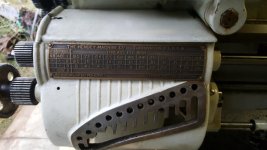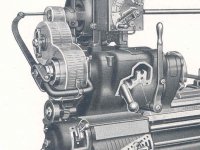IMO, with no figures to support my thinking, Southbend was likely the most prolific lathe builder. As you note, there is no comparing a Southbend lathe to a Hendey. It goes beyond apples-and-oranges. Other than both being lathes for turning metal and both being US builders, there is no other commonality that I could see.
My thinking is LeBlond may well have led the field in sheer numbers of cone-head and then geared-head engine lathes built. LeBlond lathes are quite common, and while a very good lathe, was never quite so fine a lathe as Hendey. Monarch may have been somewhere behind LeBlond in number of lathes built.
Hendey was more of a high-end lathe. I have run a number of Hendey lathes over the years, and while there is plenty of iron in them, I never thought of them as quite the bear that a Monarch or L & S of equivalent capacity would be. I always felt that for hogging off metal and heavy work, a lathe like an American or L &S was even more of a bear than a LeBlond of that same capacity. LeBlond built some heavy duty lathes and some wide-bed lathes, and offered a heavy-duty line as well. Hendey stuck to one type of lathe, in my opinion. This was a good all-around engine lathe with enough beef for most jobs but still a finer and higher-end machine tool than what you'd really want to use to hog off metal on rough forgings or castings or weldments.
Hendey was a New England builder of machine tools. I do not know the square footage that their plant occupied, but they likely had a much smaller plant than some of the lathe builders out in Cincinnati or that region. The fact that Hendey was also building shapers, and was making their own collets was a clue as to the kind of production their plant had. The Hendey information on Tony Griffith's "Lathe Archive" site also goes into the capacity of the biggest turbo-generator in the Hendey plant's powerhouse. It is maybe 500-600 Kw. Equate this with numbers of production machine tools with 15-20 HP motors and running bridge cranes, and that 500-600 Kw does not equate with a huge plant like some of the midwest lathe builders had.
We used Hendey geared head engine lathes in our junior and senior years in the Mechanical Course at Brooklyn Technical HS. Our teacher, Mr. Almskog, was a tool and die maker who'd returned to his alma mater to teach. He had a real appreciation for the Hendey lathes and explained a lot of the features of them that made them a cut or two above the other lathe builders.
Years later, another fine machinist explained why the Monarch lathes were a cut above, basing his opinion on the fact that Monarch used helical gears and dog clutches in the headstock. He was doing a lot of work on high speed pump bearings, boring babbited bearings in Monarch lathes. His experience with the Monarchs- and these were War Production Board engine lathes, not anything special- was that the helical gears in the headstock did not leave any "tooth marks" in the surface finish when he bored the babbitted bearings.
Another fine man and authority on lathes, the late Robert Yancey, was a proponent of LeBlond lathes for heavy work. Mr. Yancey had been around heavy lathes a long time and had met R.K. LeBlond. Mr. Yancey acquainted me with a number of LeBlond's design features, and we wound up buying two used wide bed LeBlond lathes from him. Different animal entirely than a Hendey lathe, different use for those lathes.
On the other hand, if we were to compare a "square head" LeBlond Regal lathe to a Hendey of equal capacity, I'd say the Hendey was a far better lathe, hands down, based on my own experience.
BTW: At Brooklyn Tech HS, we had almost no Southbend lathes in the entire school's shops. There must have been somewhere near 60 or so engine lathes in the school's machine shop classrooms. Some were ancient overhead drive cone head lathes. Some were geared head lathes from makers like Lodge-and-Shipley, Sidney, Bradford, Reed-and-Prentice, and Hendey. Two shop classrooms had just been modernized when I took my first machine shop classes. These classrooms had just been converted from lineshaft driven machine tools to modern machine tools with individual motor drives. In those classrooms, the engine lathes were the "square head" LeBlond Regal lathes. How many times do HS kids get to run very nearly brand-new engine lathes and other machine tools ? Our teachers, along with the rest of us kids, all regarded Southbend lathes as a kind of "tinkertoy" or "mickey mouse" lathe, not much of a lathe. Of course, when you go back to the 1960's and get a bunch of boys in a technical HS, boys being what they were back then, we all wanted to run the heaviest machine tools. We got to run a variety of engine lathes, but when we got into our junior and senior years, the Hendey geared head lathes were it. Just a finer machine tool all around.







